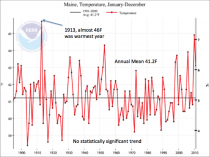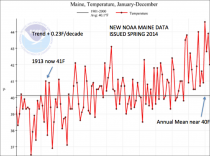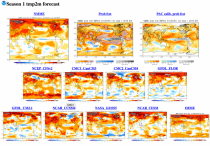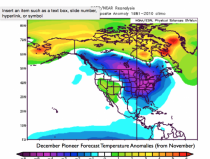Dec 08, 2016
Nonsense Sea Level Alarmism; Manipulating climate data right before our eyes UPDATED
Michael Sununu, Union Leader
Important Update:
The Coastal Flood Risk report nonsense for NH refuted by real data in report that gets coverage in the Union Leader and NHPR. Michael shows how the university environmentalists continue to deliver self serving failing model based forecasts that will cost taxpayers billions. We should cut off funding for these programs and studies. As is usually the case the rebuttal was done pro bono.
--------------
Manipulating Climate Data Right Before Our eyes
THE RECENT ELECTIONS have caused the climate alarmists’ heads to spin. Without a liberal President to force green policies on America, there is little chance their agenda will move forward. Regardless of policy preferences, what elected officials need to focus on is what is actually going on in our climate and what steps need to be taken to address them. It’s the data that count. The real data.
On this point, let’s all agree that the world is warming. It has been since the 1800s when the world started to emerge from the Little Ice Age. We have had periods of warming, periods of cooling and periods when global temperatures didn’t do much of anything.
The bigger question is “Are we seeing recent temperature trends that are out of the ordinary of what we have seen in the past?” Alarmists tend to scream that temperatures are rising out of control, in an unprecedented manner, and that we are reaching a tipping point beyond which we are doomed.
That is all a lie, but I am sure they believe it.
Let’s look at the data, and just as importantly what alarmists have been doing to the data.
If you look at raw global surface temperatures, you see the rate of increase in the early part of the 20th century is the same as what occurred from the late 1970s to the late 1990s. No one has argued the first rate of change was anything but natural. So why must the more recent warming be manmade? In addition, we saw a flat/downward trend in global temperatures from the 1940s to the 1970s and we saw, at least up until recently, another almost 20 year flat temperature period to start this century.
So if what we are seeing are trends that are no different than in the past, why should we think it is anything but natural? We shouldn’t. In fact, any scientist should assume that nature is driving global temperatures and prove otherwise before arguing that mankind is driving our climate. One of the dirty little secrets of the alarmists is that they haven’t been able to prove that. They like to point to the correlation of rising carbon dioxide levels and temperatures as “proof”, but even a third grader knows that isn’t proof. Their climate models certainly make it look warmer, but the model forecasts are terrible, only proving that the models don’t work.
So what is a climate alarmist to do? Well if you don’t want to fix the models, you fix the temperatures. And that is exactly what has been going on.
Anyone who has closely followed the climate debate is familiar with the “adjustments” to the raw temperature data. What most Average Joes don’t realize is that the adjustments are almost entirely done to accomplish one thing - cool the past and warm the present.
How did they do this? Scientists have “smoothed” regional temperatures to get better agreement between urban and rural data. But instead of adjusting city temperatures lower (because of urban heat effects) they raised rural temperatures. More recently, in order to get rid of the “pause” in temperatures, they adjusted the sea surface temperatures higher when they decided that mid-20th century temperatures taken in ship engine intakes are more accurate than the modern ocean buoys. That’s right, the technology of the 1950s with the ship engine heat influencing the data was determined to be better than the network of modern electronics uninfluenced by external heat sources. And these are only a few examples of what has been going on.
On a more local level, between 2011 and 2013, the NOAA data set lowered annual Maine temperatures between three to five degrees in the early 1900s....and made almost no changes to recent temperatures. That “adjustment” is more than three times the actual warming we have seen.

Enlarged

Enlarged
When you look at how temperatures have been manipulated you start to wonder if we have any idea what the global temperature is. Over the past decade or so, the keepers of the data have cooled temperatures in the pre-1910 period the equivalent of -0.52 degrees per century. They warmed temperatures from 1980 to the early part of this century by the equivalent of +0.11 degrees per century.
Those two changes represent half the warming since 1900! And this was before the “pause buster” sea surface temperature manipulation took place.
Keep this in mind when the alarmists start demanding more action. When every iteration of the global temperature data set incrementally warms the present and cools the past, it’s not science. It’s manipulation. Mother Nature is still driving the climate, no matter how much they fudge the data for their agenda.
Michael Sununu is a small businessman and selectman in Newfields.

Enlarged
Dec 07, 2016
Historic December cold and Lake-effect snows coming
Joseph D’Aleo, CCM, AMS Fellow
As is frequently the case, the climate models can’t forecast even a month ahead. Similar models are run 100 years into the future. We are supposed to believe they are accurate. I could name a dozen reasons why they w 814temp ill not be. They tell us they will go to faster computers and higher resolution but that simply produces higher resolution noise.

Enlarged
CPC forecasters did see some potential at the end of November for some cold in the northwest.

Enlarged
But WeatherBell’s statistical Pioneer model in November saw a much colder December.

Enlarged
CPC came around to that cold mid month (they had it cold the next week) in their 8-14 day Tuesday.

Enlarged
The models show brutal cold the next 15 days - these are anomalies of near surface temperatures in degree celsius (they show anomalies of -40F or more in the core of the cold!)
These next three maps are 5 day increments:

Enlarged

Enlarged
 Enlarged
Enlarged
Here is what we call a Meteogram for Chicago O’Hare from the US GFS model. It shows three sub zero day with lows near -10F. The usually more accurate European model takes them to -15F!

Enlarged
The many days of extreme cold crossing the warm Great Lakes will bring historic lake effect snows. Expect broadcasters and newspapers spouting the liberal lines and the AMS/GMU doctrine standing on the snowbanks and blaming it on global warming.

Enlarged
Here is a link to slides showing how the statistical models we use that includes factors the dynamical models ignore beat the dynamical models and official forecasts in recent years.
If you are in a weather sensitive industry, you should take a look at Weatherbell.com and follow our model, our (Joe Bastardi and I) daily blog posts and videos through this incredible stretch and winter.
Nov 17, 2016
A new morning for the environment
Anthony Sadar
As the memorable Ronald Reagan political ad announced, “It’s morning again in America.”
Hopefully, following the election of Donald Trump, a bright new day will dawn for environmental protection in the United States.
One federal agency that needs immediate attention after the swearing in of President Trump is the Environmental Protection Agency (EPA). Founded in 1970 under Republican President Richard Nixon, this powerful agency had an admirable goal to clean up the mess overtaking the nation’s air, water and land at that time. Since 1970, tremendous progress has been made on all major environmental fronts. In particular our air quality has improved 70 percent from reduction of major contaminants.
Today’s EPA is a far cry from the agency of the ‘70s. As a candidate, Mr. Trump asserted the day before the historic election government should serve the nation, not the special interests. The EPA appears to be serving the environmentalists’ special interest. And arrogant activism apparently keeps rolling along at the highest levels of the EPA.
The head of the EPA, Gina McCarthy, seems to be on shaky ground when it comes to atmospheric science. Like many others, she must have faith in climatologists. Lucky for her, the largely academic and government-supported climate scientists bolster presuppositions about the climate. These presumptions are based on an ideology, which is apparently founded on an environmentalist universalism. Such religion is rooted in years of unrelenting indoctrination in the catechism that humans are destroying the planet by living comfortably off fossil fuels.
From what appears to be a superficial, faith-based knowledge of the climate change issue, the EPA’s Ms. McCarthy has recently said, “I’m not talking to climate deniers - that’s it.” Spoken like a true believer.
It is offensive to many of us secular, knowledgeable, practicing atmospheric scientists that the top EPA official spouts denigration and demands obeisance to ecological religion. With a Trump administration, perhaps we deplorable unbelievers will have some voice to provide perspective on the complex issue of climate change, its magnitude and reasonable mitigation.
Some climate facts are well established, such as the observation that man’s activity on the local and medium scales has affected climate. Cities that replaced vegetative areas with developments show measurable increases in temperature and other long-term changes to atmospheric dynamics when compared with the surrounding countryside. The latest issue of Physics Today focuses on some climate changes related to land-surface and land-management changes.
Weather patterns can change from humans’ untoward inputs to not only landscape changes but, to a minor extent, increased loading of particulate matter and volatile organic compounds into the atmosphere. However, since draconian measures to reduce “greenhouse gases” will lead to, at best, a small fraction of a degree decrease in global temperatures, it makes more sense to focus time and talent at the EPA on further reducing toxic pollutants that pose a real threat to public health. Healthful communities will result from the feds working diligently with job-growing industries to reasonably limit harmful emissions. Command-and-control strategies from the EPA do not enrich populations if the strategies drive out business and padlock factories.
People do have some substantial, limited impact on climate. But, how serious and to what extent are questions far from being answered in any “settled science” way.
Arrogant government elites, politicians and academic scientists must shut down quality challenges to their faith in themselves, and so the EPA must be more broad-minded, opening a big tent to legitimate, informed questions regarding the entrenched idea that the climate is controlled by paltry people pollution.
Anthony J. Sadar is a certified consulting meteorologist and author of “In Global Warming We Trust: Too Big to Fail” (Stairway Press, 2016). Susan T. Cammarata is a practicing environmental and family lawyer.
----------
Energy Independence
The Trump Administration will make America energy independent. Our energy policies will make full use of our domestic energy sources, including traditional and renewable energy sources. America will unleash an energy revolution that will transform us into a net energy exporter, leading to the creation of millions of new jobs, while protecting the country’s most valuable resources - our clean air, clean water, and natural habitats. America is sitting on a treasure trove of untapped energy. In fact, America possesses more combined coal, oil, and natural gas resources than any other nation on Earth. These resources represent trillions of dollars in economic output and countless American jobs, particularly for the poorest Americans.
Rather than continuing the current path to undermine and block America’s fossil fuel producers, the Trump Administration will encourage the production of these resources by opening onshore and offshore leasing on federal lands and waters. We will streamline the permitting process for all energy projects, including the billions of dollars in projects held up by President Obama, and rescind the job-destroying executive actions under his Administration. We will end the war on coal, and rescind the coal mining lease moratorium, the excessive Interior Department stream rule, and conduct a top-down review of all anti-coal regulations issued by the Obama Administration. We will eliminate the highly invasive “Waters of the US” rule, and scrap the $5 trillion dollar Obama-Clinton Climate Action Plan and the Clean Power Plan and prevent these unilateral plans from increasing monthly electric bills by double-digits without any measurable effect on Earth’s climate. Energy is the lifeblood of modern society. It is the industry that fuels all other industries. We will lift the restrictions on American energy, and allow this wealth to pour into our communities. It’s all upside: more jobs, more revenues, more wealth, higher wages, and lower energy prices.
The Trump Administration is firmly committed to conserving our wonderful natural resources and beautiful natural habitats. America’s environmental agenda will be guided by true specialists in conservation, not those with radical political agendas. We will refocus the EPA on its core mission of ensuring clean air, and clean, safe drinking water for all Americans. It will be a future of conservation, of prosperity, and of great success.
Oct 31, 2016
Annals Of Fake, Politicized “Science”
Francis Menton
If you have never read President Dwight Eisenhower’s January 1961 farewell address, you should. It’s not long. He clearly foresaw the oncoming unchecked expansion of the federal government, and the associated dangers. The famous passage deals with the risks to science from the new-found gusher of federal grant spending:
A steadily increasing share [of scientific research] is conducted for, by, or at the direction of, the Federal government. Today, the solitary inventor, tinkering in his shop, has been overshadowed by task forces of scientists in laboratories and testing fields. In the same fashion, the free university, historically the fountainhead of free ideas and scientific discovery, has experienced a revolution in the conduct of research. Partly because of the huge costs involved, a government contract becomes virtually a substitute for intellectual curiosity… The prospect of domination of the nation’s scholars by Federal employment, project allocations, and the power of money is ever present - and is gravely to be regarded.
Fast-forward 55 years, and we are deep in the dystopia that Eisenhower foresaw. In science today, government funding is everything, and control of it empowers orthodoxy enforcement and the banishment of skeptics and dissenters—the antithesis of science. Many examples can be cited of science gone completely off the rails through the perverse incentives of government monopoly funding (see, for example, my posts on the government-backed low fat diet, here and here). But really, nothing can top the hysteria—underwritten by tens of billions of dollars of annual federal spending—of the climate change machine.
Readers here are well aware that the scientific house of cards of anthropogenic global warming becomes more unstable with each passing day. As adverse information continues to pour forth—from the Climategate emails, to the near-twenty-year unexplained “pause” in world temperature rise, to repeated revelations of alterations of historical temperature records by government functionaries trying to support the failing warming narrative—nothing slows down the federally-funded juggernaut of political climate activism and fossil fuel restriction. The most recent body blow to the catastrophic warming narrative was the Research Report from Wallace, et al., reported here last month, showing no statistically significant warming in any major world temperature time series after controlling only for concededly-non-anthropogenic El Nino and La Nina effects.
So where do our major scientific societies stand on this issue? If you don’t already know, you will be demoralized to learn that, with one notable exception, the principal societies are on record as supporting the official government narrative of dangerous human-caused global warming. In June 2016, some 31 scientific societies sent a joint letter to Congress, supposedly to “remind [it] of the scientific consensus view of climate change,” and to urge further government action to restrict fossil fuel use. You can follow the link to get the complete list of subscribing societies, and if you do, see if you can spot the big one that is missing. It’s the American Physical Society, the association of physicists! But, you ask, isn’t the so-called “science” of “climate change” a matter specifically of atmospheric physics? Turns out that the APS commissioned a review of the science of climate change by a panel of its own members in 2014, and the panel’s report failed to support the consensus “science.” A battle continues to rage on the issue at the APS (you can read more about it here) but meanwhile, the key fact is that group of people who actually know the subject matter has so many dissenters and skeptics that it hasn’t joined the bandwagon.
So who has joined the bandwagon? Well, as an example, there’s the American Society of Ichthyologists and Herpetologists. Do they know anything about climate physics? Probably not much. But they do know that if you want to study snakes and you want to go where the government money is, you will put something about global warming in your grant proposal. How about seeking a grant for “the effect of global warming on the range of the lesser eastern tree boa”? That should work!
Anyway, the issuance of the Wallace, et al., Research Report prompted me to join up with Alan Carlin, an MIT-trained economist and 40-year senior analyst and manager at EPA, to send letters last Friday to each of the 31 unscientific scientific societies demanding to know the alleged scientific basis for their position on climate change in light of the recent findings. The full text of our letter can be found here. A few key excerpts:
The June 28 Letter to which you subscribed contains statements strongly implying that there had previously been some sort of empirical validation of a quantitative causal relationship between increasing atmospheric greenhouse gas concentrations and increasing global average surface temperatures. . . . However, as noted above, the authors of the [Wallace, et al.] Research Report have been unable to find in any scientific study a rigorous empirical validation of a statistically significant quantitative relationship between rising greenhouse gas concentrations and tropical, contiguous U.S. or global temperatures. Indeed we can find no paper that actually provides mathematically rigorous empirical proof that the effect of increasing atmospheric greenhouse gas concentrations on world temperatures is different from zero with statistical significance.
As you might realize, we are concerned that prestigious scientific societies, including your own, have subscribed to a letter to Members of Congress purporting to convey scientific propositions as having been definitively established, when in fact there has never been a mathematically rigorous empirical validation of the propositions stated, and indeed there now appears to be a definitive scientific invalidation of those propositions. . . .
In short, if you have mathematically rigorous empirical validation of the hypotheses that underlie your advocacy, kindly provide it. If you do not, kindly say so.
Joseph D’Aleo (one of the co-authors of the Wallace, et al., Report) has posted the full text of our letter, along with commentary, on his excellent ICECAP website. Carlin’s treatment of the subject can be found at his CarlinEconomics website here. D’Aleo minces no words in his description of the corruption of the unscientific scientific societies:
The once professional societies continued their slide into unprecedented advocacy in recent years as they boarded the politically-driven grant gravy train and recruited to their memberships a whole generation of eco fanatics indoctrinated in our failing schools at all levels. Their advocacy with congress is not at all scientific.
Oct 27, 2016
Hillary Clinton Is No Hurricane Expert - But I Am
Dr. Neil Frank
As former Director of the National Hurricane Center (1974-1987), I was appalled when, in a campaign rally at Miami-Dade College October 11, Democratic Presidential candidate Hillary Clinton said, “Hurricane Matthew was likely more destructive because of climate change.” That is false.

We were extremely fortunate that Matthew - category 5 through much of the Caribbean - weakened to category 2 before landfall in South Carolina. It could have been much worse.
In 1893 a much stronger hurricane followed nearly the same track. When its eye reached the Georgia and South Carolina coasts, a 15-20 ft. storm surge inundated the coastal islands. Though population was a small fraction of today’s, between 2,000 and 3,000 died, making that the second deadliest hurricane in U.S. history. The same year another major hurricane killed 2,000 in Louisiana.
All together five hurricanes hit the U.S. in 1893, something that’s happened only 4 times in over 150 years (1886, 1893, 1916, 1933) - all long before CO2 levels rose enough to theoretically cause rapid global warming.
Clinton wants us to believe CO2, emitted when we burn fossil fuels for electricity and transportation vital to life, health, and prosperity, causes global warming that causes more and stronger hurricanes. She’s wrong.
There has been a worldwide 30-year lull in hurricanes, typhoons, and cyclones despite the simultaneous warming - manmade or natural. It has been 11 years since a major hurricane hit the U.S. Before that we expected, on average, 1 every 2 years. In the 7 years 1944-1950, well before the rapid rise of CO2, 6 hit Florida alone.
Clinton is ignorant about more than hurricanes. Based on computer climate models that fail test after test, predicting two to three times the observed warming, she claimed that because of rising sea level driven by manmade warming, “one in eight homes in Florida could be underwater by the end of the century.”
Empirical observation says otherwise. Since 1992 sea level in Miami has risen only a little over 1 inch - a rate of 4.2 inches per century, no faster than for millennia. Mrs. Clinton is wrong. It’s not time to move to the mountains.
Yes, Earth’s atmosphere is warming. It has been, off and on, for 150 years. What causes it? CO2, natural cycles, or some combination? Sun and ocean current cycles correlate better with global temperature than CO2.
If CO2 doesn’t control Earth’s temperature, why has our government spent some $150 billion on “green energy” alone - not to mention billions on research to bolster belief in man-made warming - over the last 15 years?
What do we have to show for it? We lost $500 million when solar panel maker Solyndra went bankrupt. In 2009 we subsidized 11 electric car companies for $2.5 billion. Six are bankrupt and 5 floundering. In 2015 Sun Edison, America’s largest “green energy” company, went bankrupt, costing us $3 billion. Abergeo, the largest international solar energy company, threatens bankruptcy costing us $2.5 billion. We’ve committed $3.5 billion toward a $100 billion climate fund for developing nations.
Projected future costs are staggering. Clinton wants to build and install 500 million new solar panels in the next four years. The Institute for Energy Research estimates this will cost $205 billion plus higher electric rates for consumers. She wants all residential energy to be “green” by 2025.
A peer-reviewed study concludes that full implementation of the Paris climate agreement, which Clinton supports, would cost $1-$2 trillion per year ($70-$144 trillion from 2030-2100). The payoff? An inconsequential 0.3F reduction in global average temperature.
If climate alarmists want to protect life, why aren’t they as concerned about the 1.5 billion people without electricity and the 2-3 billion without pure water? Millions die each year from these two factors. At a fraction of the cost of fighting global warming, electricity from abundant, affordable, reliable fossil fuels, not diffuse, expensive, intermittent wind and solar, could prevent those deaths.
Neil L. Frank, Ph.D. (Meteorology), the longest-serving Director of the National Hurricane Center (1974-1987) and retired Chief Meteorologist of KHOU-TV, Houston (1987-2008), is a Fellow of the Cornwall Alliance for the Stewardship of Creation.
Read more: http://dailycaller.com/2016/10/27/hillary-clinton-is-no-hurricane-expert-but-i-am/#ixzz4OJclPFrn
|















